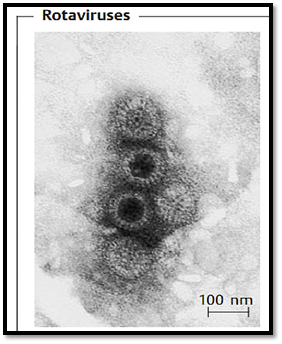


 النبات
النبات
 الحيوان
الحيوان
 الأحياء المجهرية
الأحياء المجهرية
 علم الأمراض
علم الأمراض
 التقانة الإحيائية
التقانة الإحيائية
 التقنية الحيوية المكروبية
التقنية الحيوية المكروبية
 التقنية الحياتية النانوية
التقنية الحياتية النانوية
 علم الأجنة
علم الأجنة
 الأحياء الجزيئي
الأحياء الجزيئي
 علم وظائف الأعضاء
علم وظائف الأعضاء
 الغدد
الغدد
 المضادات الحيوية
المضادات الحيوية|
Read More
Date: 19-11-2015
Date: 29-10-2015
Date: 20-11-2015
|
Reoviruses
Reoviruses possess a segmented, double-stranded RNA genome. Among the reoviruses, the rotaviruses are the most significant human pathogens. They cause diarrhea in small children and the elderly and can also produce severe sequelae in immunosuppressed patients.
Diagnosis: reovirus—isolation; rotavirus—antigen detection or electron microscopy. Isolation of this viral type in cell cultures is not a routine method.
Pathogen. The name reovirus is derived from the abbreviation for respiratory enteric orphan virus, recalling that no diseases were associated with the virus upon its discovery (hence “orphan virus”). The family Reoviridae includes, in addition to phytopathogenic and zoopathogenic strains, three genera in which human pathogens are classified:
-Coltiviruses include a large number of pathogens significant in veterinary medicine as well as the human pathogen virus that causes Colorado tick fever.
-Reoviruses in the narrower sense, with three serogroups.
-Rotaviruses, groups A to F, further subdivided into subgroups, serotypes, and electropherotypes (see below). The rotaviral genome consists of eleven segments of double-stranded RNA. Each segment codes for one viral protein. Some segments in other reoviruses code for two or three proteins.
Pathogenesis and clinical picture.
-Coltiviruses. Colorado tick fever usually runs a mild course with fever, myalgias, nausea, and vomiting, rarely encephalitis.
-Reoviruses. Implication of these viruses in diseases is still uncertain. It appears they are capable of infecting the respiratory and intestinal tracts of children. The fact that they are also found very frequently in asymptomatic persons makes it difficult to correlate them with specific clinical pictures.
-Rotaviruses. In the mid-seventies these viruses were recognized as diarrhea-causing viruses in infants and small children (Fig. 8.15). They are the most frequent cause of diarrhea in children aged six months to two years. It was recently discovered that they also play a role in infections of the elderly, and above all in immunosuppressed patients (e.g., bone marrow transplant patients), and can cause severe clinical pictures in these groups. Rotaviruses enter the body per os or by droplet infection, replicate in the villi of the small intestine and cause diarrhea, potentially resulting in exsiccosis.
Diagnosis. Colorado tick fever can be diagnosed serologically. Reovirus infections can be diagnosed by isolating the pathogens in cell cultures. Rotaviruses do not readily grow in cell cultures for diagnostic purposes. They can be detected more readily under an electron microscope or in antigen assays using commercially available solid phase tests (EIA) or passive agglutination. An elegant typing method for the different rotavirus strains involves analysis of the electrophoretic mobility of the 11 dsRNA strands of the viral genome.
Epidemiology. Humans are the sole natural reservoir of the infant pathogen rotaviruses. Generalized contamination is practically 100% when children reach school age, but carriers and reinfections are still possible despite immunity. Diarrheal infections are among the most important causes of death in small children in developing countries; 20% of these infections are due to rotaviruses. In the temperate zone, rotaviruses are implicated in fewer individual infections; here they more frequently cause winter outbreaks in hospitals and homes for small children. Rotaviruses remain viable for long periods on objects and skin (hands!) and are therefore spread rapidly by infected persons and healthy carriers. The most effective prophylactic approach is to practice stringent hygiene.

Fig. 1 TEM image of rotaviruses in stool from an infantsuffering from diarrhea. All of the viruses in the family Reoviridae possess a double icosahedral capsid. The outer capsid has a diameter of approximately 70 nm, the inner capsid approximately 40 nm. It contains the segmented RNAgenome, comprising from 10 to 12 double-stranded subunits depending on the species.



|
|
|
|
حمية العقل.. نظام صحي لإطالة شباب دماغك
|
|
|
|
|
|
|
إيرباص تكشف عن نموذج تجريبي من نصف طائرة ونصف هليكوبتر
|
|
|
|
|
|
بمشاركة 60 ألف طالب.. المجمع العلمي يستعدّ لإطلاق مشروع الدورات القرآنية الصيفية
|
|
|
|
صدور العدد الـ 33 من مجلة (الاستغراب) المحكمة
|
|
|
|
المجمع العلمي ينظّم ورشة تطويرية لأساتذة الدورات القرآنية في كربلاء
|
|
|
|
شعبة التوجيه الديني النسوي تختتم دورتها الثانية لتعليم مناسك الحجّ
|